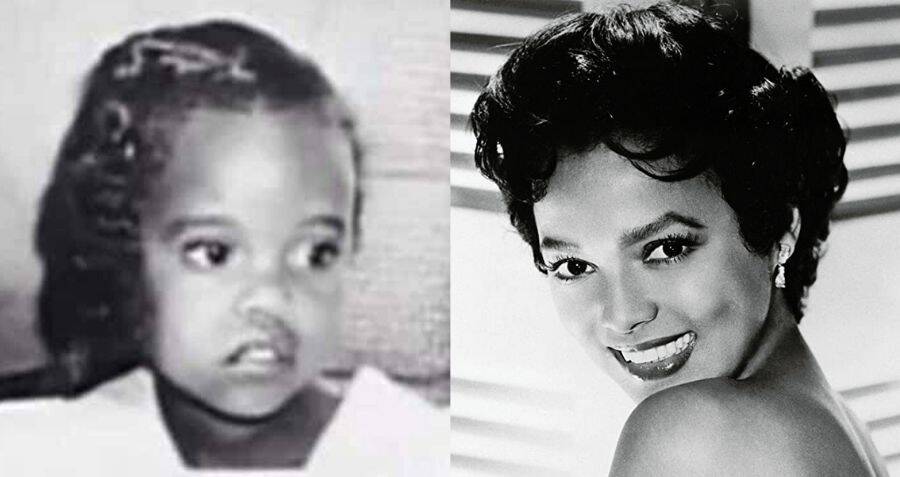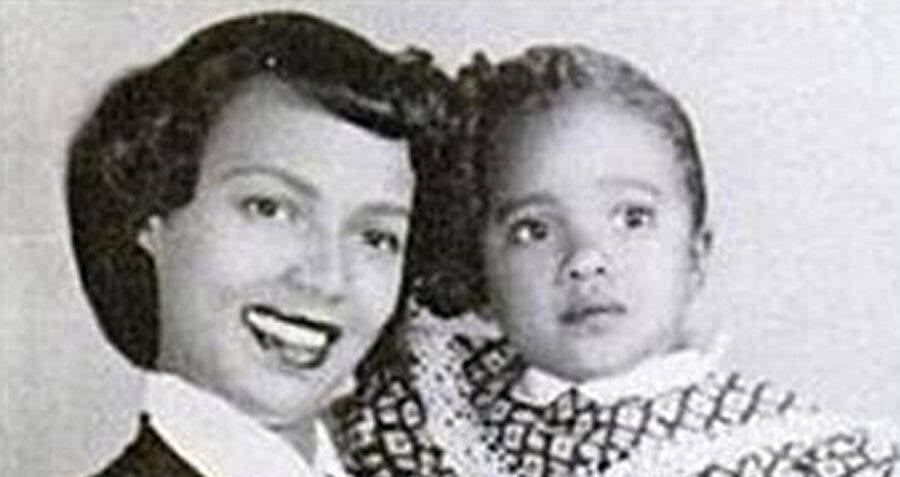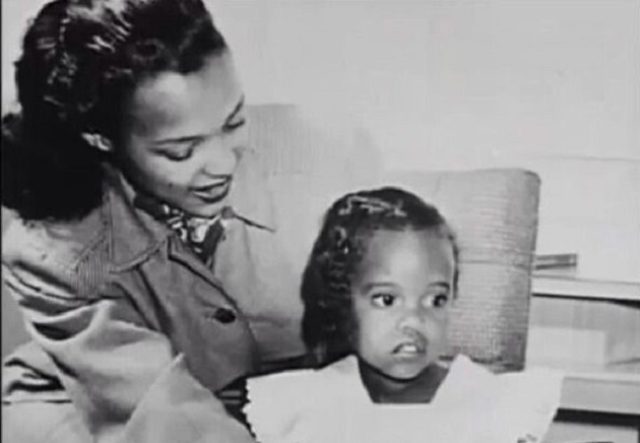Harolyn Suzanne Nicholas: A Life Shrouded In Hollywood Tragedy
In the dazzling world of Hollywood's Golden Age, where glamour and fame often masked profound personal struggles, few stories are as poignant and heartbreaking as that of Harolyn Suzanne Nicholas. Born to the iconic actress Dorothy Dandridge and the legendary dancer Harold Nicholas, Harolyn's life was tragically marked by a severe disability from birth, casting a long shadow over her mother's illustrious career and her own existence. Her story is a stark reminder that beneath the glittering facade of celebrity, real human struggles unfold, often out of the public eye.
While her mother, Dorothy Dandridge, captivated audiences with her beauty, talent, and groundbreaking achievements, Harolyn Suzanne Nicholas lived a life largely hidden from the spotlight, grappling with challenges that were rarely discussed openly in an era less understanding of neurological conditions. This article delves into the life of Harolyn, exploring the circumstances of her birth, her profound impact on Dorothy Dandridge, and the enduring questions surrounding her care and well-being, particularly after her mother's untimely death. We aim to shed light on a narrative often overlooked, offering a more complete picture of a life shaped by both love and immense hardship.
Table of Contents
- The Unseen Life of Harolyn Suzanne Nicholas
- The Legacy of a Difficult Birth
- Dorothy Dandridge's Devotion and Despair
- The Absence of Accountability: Harolyn's Later Years
- Harold Nicholas: A Father's Distance
- Public Perception and Lingering Questions
- The Broader Context: Disability in Mid-20th Century America
- Remembering Harolyn: A Call for Empathy
The Unseen Life of Harolyn Suzanne Nicholas
To truly understand the narrative of Harolyn Suzanne Nicholas, one must first appreciate the extraordinary world into which she was born. Her mother, Dorothy Dandridge, was a trailblazer, breaking racial barriers in Hollywood and becoming the first African American woman nominated for an Academy Award for Best Actress. Her father, Harold Nicholas, was one half of the iconic Nicholas Brothers, renowned for their electrifying dance routines. Their union, though ultimately short-lived, brought forth a child whose life would be defined by challenges far removed from the glamour of her parents' careers.
- Truist One View Customer Service
- Project Escape Room Roblox School
- Uncut Webseries
- Jackerman Mothers Warmth
- Sajal Malik
Early Life and Birth Complications
Harolyn Suzanne Nicholas was born on September 2, 1943, a date that would forever alter Dorothy Dandridge's life. The birth proved to be a difficult one. Accounts suggest that on the day Dandridge went into labor, she ignored the pains, perhaps due to her husband, Harold Nicholas, still being in Europe, though he was due to return. This delay in seeking medical attention is often cited as a critical factor in Harolyn's subsequent health issues. Tragically, Harolyn was born with brain damage, reportedly due to the doctor's use of forceps during the delivery, which caused a lack of oxygen to her brain. Despite the traumatic birth, Dorothy initially believed that the baby, whom she named Harolyn Suzanne Nicholas, seemed alright and held onto the hope that her child would bring her and Harold closer, a symbol of their love and a source of future joy.
However, as Harolyn grew, it became painfully clear that she was not developing typically. Her condition, likely cerebral palsy or a similar neurological impairment, meant she would require lifelong specialized care. This reality was a devastating blow to Dorothy, who had envisioned a different future for her child. The initial hope that Harolyn would be a unifying force in her parents' lives soon gave way to the harsh realities of her condition, which placed immense strain on Dorothy, both emotionally and financially. Harolyn was described as a beautiful child, but her profound needs quickly became the primary focus of Dorothy's life, overshadowing her burgeoning career.
A Mother's Struggle: Dorothy Dandridge's Burden
Harolyn Suzanne Nicholas became, in many ways, the "primary ghost" in Dorothy Dandridge's life. Her daughter's condition was a constant source of worry, guilt, and immense pressure. Dorothy dedicated herself to Harolyn's care, exploring every possible avenue for treatment and support. This was an era when resources for children with severe disabilities were far less developed and accessible than today, particularly for Black families. The societal understanding and acceptance of such conditions were also limited, often leading to isolation and stigma for affected families.
- Asser Malik
- Elizabeth Olsen
- American Airlines Affected By Outage What Happened And How It Impacted Passengers
- Peter Doocy Wife Cancer
- Price Is Right Salaries
The financial burden of Harolyn's care was enormous. Dorothy, despite her celebrity, struggled to manage the costs of specialized facilities and medical attention. This financial strain often pushed her to take on roles she might not have otherwise, and it contributed significantly to her own personal and professional decline. The constant worry about Harolyn's well-being, coupled with the demands of her career and the pressures of racial prejudice in Hollywood, took an immense toll on Dorothy's mental and emotional health. Her daughter's condition was a deeply personal and often private struggle, yet it profoundly shaped every aspect of her public and private life.
Personal Data: Harolyn Suzanne Nicholas
While specific details about Harolyn Suzanne Nicholas's life are scarce due to her private existence, here is a summary of known information:
| Attribute | Detail |
|---|---|
| Full Name | Harolyn Suzanne Nicholas |
| Nickname | Lynn |
| Date of Birth | September 2, 1943 |
| Parents | Dorothy Dandridge (Mother), Harold Nicholas (Father) |
| Cause of Disability | Brain damage at birth, reportedly due to forceps use during delivery causing oxygen deprivation. |
| Condition | Severe neurological impairment (likely cerebral palsy or similar condition), requiring lifelong care. |
| Date of Death | Undisclosed/Not widely publicized (lived into her 60s, passing away in 2003, though exact date often not cited in public records). |
| Place of Care | Primarily in private institutions/specialized care facilities. |
The Legacy of a Difficult Birth
The circumstances surrounding Harolyn Suzanne Nicholas's birth are a crucial element in understanding her life and her mother's struggles. The medical practices of the 1940s, while advancing, were not without their risks. The use of forceps, a common obstetric tool, carried the potential for complications if not handled with extreme precision. The reported oxygen deprivation at birth, leading to brain damage, highlights the vulnerability of newborns and the critical importance of timely and expert medical intervention during labor and delivery.
For Dorothy Dandridge, the guilt and anguish over Harolyn's condition were immense. Whether she truly delayed seeking medical attention or if the complications were simply an unforeseen tragedy, the outcome was devastating. This event set the trajectory for Harolyn's life, defining her needs and shaping the choices and sacrifices her mother would make. The legacy of that difficult birth extended far beyond the delivery room, impacting the emotional landscape of the Dandridge-Nicholas family for decades. It underscores a period in medical history where understanding of neonatal care and neurological conditions was still rudimentary, leaving families like the Dandridges to navigate complex challenges with limited support and information.
Dorothy Dandridge's Devotion and Despair
Dorothy Dandridge's life was a complex tapestry of triumphs and tragedies, with Harolyn Suzanne Nicholas at its emotional core. Despite the immense pressures of her career and the societal expectations placed upon her as a Black woman in Hollywood, Dorothy's devotion to her daughter was unwavering. She tirelessly sought the best care for Harolyn, often sacrificing her own financial stability and well-being in the process. She placed Harolyn in private institutions, hoping to provide her with the specialized environment she needed. This was not a decision taken lightly, as it meant separation from her child, a painful choice for any mother.
However, this devotion was often intertwined with profound despair. The constant worry about Harolyn's future, the financial strain, and the emotional toll of her daughter's condition contributed significantly to Dorothy's own struggles with depression and, ultimately, her tragic early death in 1965. Harolyn's needs were a driving force in Dorothy's life, but also a source of immense sorrow and exhaustion. The narrative often portrays Harolyn as a "burden," but it is more accurate to view her as the central, heartbreaking reality of Dorothy's private life, a reality that she grappled with until her final days. Dorothy's struggle highlights the often-invisible sacrifices made by caregivers, especially parents of children with severe disabilities, and the profound impact such responsibilities can have on their own lives.
The Absence of Accountability: Harolyn's Later Years
Perhaps one of the most haunting aspects of Harolyn Suzanne Nicholas's story is what transpired after her mother's death. Dorothy Dandridge passed away in 1965, leaving Harolyn, then 22 years old, in institutional care. The poignant statement, "I shudder to think what Harolyn went through for 40 years after Dorothy's death w/ no family for her caretakers to be accountable to," speaks volumes about the vulnerability of individuals like Harolyn. With her mother gone, and her father, Harold Nicholas, largely absent from her life, Harolyn was left without a primary advocate or family member to oversee her care. This raises critical questions about oversight, quality of life, and potential neglect in long-term care facilities during that era.
In the mid-20th century, and even into the late 20th century, the rights and oversight for individuals with severe disabilities in institutional settings were often lacking. Without a dedicated family member regularly visiting, monitoring, and advocating for their needs, residents could easily become isolated and vulnerable. While we have no specific details of Harolyn's day-to-day experiences during these decades, the general historical context of institutional care for people with disabilities suggests that conditions could vary widely, and accountability was often minimal. Harolyn lived for another 38 years after her mother's death, passing away in 2003. Her long life in care, largely out of the public eye and seemingly without consistent family oversight, is a stark reminder of the ethical imperative for robust systems of accountability and advocacy for vulnerable populations.
Harold Nicholas: A Father's Distance
While Dorothy Dandridge bore the primary weight of Harolyn Suzanne Nicholas's care and the associated emotional and financial burdens, Harold Nicholas, Harolyn's father, appears to have maintained a significant distance. Their marriage deteriorated by the late 40s, and Harold then decided to move on, both professionally and personally. His career as a celebrated dancer continued, but his involvement in Harolyn's life became increasingly minimal. This absence is a recurring theme in discussions about Harolyn's story. While it is not uncommon for fathers to be less involved in the daily care of children with disabilities, especially in that era, Harold's apparent detachment left Dorothy to shoulder the immense responsibility largely alone.
The reasons for his distance are complex and not fully documented. It could have been a combination of the strain of the marriage, the overwhelming nature of Harolyn's condition, or simply a personal inability to cope with such profound challenges. Regardless of the reasons, his absence contributed to Dorothy's isolation and the lack of familial oversight for Harolyn after Dorothy's death. This aspect of the story highlights the often-unequal distribution of caregiving responsibilities within families, and the long-term consequences for individuals who rely entirely on external care systems.
Public Perception and Lingering Questions
The story of Harolyn Suzanne Nicholas has always been shrouded in a certain degree of mystery and sadness. Public forums like Lipstick Alley and similar threads often feature discussions asking, "What do you think really happened to Dorothy Dandridge's daughter Harolyn Nicholas?" This enduring curiosity speaks to the profound impact Harolyn's existence had on her mother's narrative and the general public's fascination with the hidden lives of celebrities' children. The lack of detailed public information about Harolyn's life, particularly her later years, fuels speculation and concern.
The public's interest is not merely sensationalism; it reflects a deeper human curiosity about the challenges faced by families, especially when those challenges are hidden behind a facade of Hollywood glamour. It also raises questions about how society views and treats individuals with disabilities, and the responsibility of public figures to acknowledge or protect their private struggles. Harolyn's story serves as a reminder that behind every famous face, there are often untold personal narratives, some of which are marked by profound pain and silent suffering. The lingering questions about her well-being underscore a collective desire for accountability and understanding, even decades after the events transpired.
The Broader Context: Disability in Mid-20th Century America
To fully grasp the challenges faced by Harolyn Suzanne Nicholas and her mother, it is essential to consider the societal context of disability in mid-20th century America. This was an era before significant advancements in disability rights, inclusive education, and community-based care. Institutionalization was often the primary, and sometimes only, option for individuals with severe disabilities. These institutions varied widely in quality, and many were characterized by overcrowding, understaffing, and a lack of therapeutic interventions. The focus was often on custodial care rather than rehabilitation or integration into society.
Families often faced immense pressure to place their children in institutions, partly due to the lack of support services at home and the prevailing medical model of disability, which viewed disabled individuals as objects of charity or medical problems to be managed, rather than as individuals with rights and potential. The stigma associated with disability also played a significant role, leading many families, including public figures like Dorothy Dandridge, to keep their disabled children out of the public eye. Harolyn's life, therefore, was not just a personal tragedy but also a reflection of broader societal attitudes and systemic limitations concerning disability care and inclusion during her lifetime. Her story implicitly calls attention to the need for continuous advocacy and improvement in care for vulnerable populations.
Remembering Harolyn: A Call for Empathy
The life of Harolyn Suzanne Nicholas, though largely lived in the shadows, carries profound lessons. It is a story that compels us to look beyond the superficial glamour of celebrity and recognize the human struggles that often lie beneath. Harolyn's existence profoundly impacted her mother's life, shaping her decisions, fueling her despair, and highlighting the immense sacrifices she made as a parent. Her story also serves as a poignant reminder of the vulnerabilities faced by individuals with disabilities, especially when family support and external accountability are lacking.
Remembering Harolyn is not just about recounting facts; it is about cultivating empathy and understanding for those who live with profound challenges, and for the caregivers who dedicate their lives to their well-being. It is a call to reflect on how society has evolved in its treatment of individuals with disabilities and to acknowledge the progress made, while also recognizing that there is always more work to be done in ensuring dignity, respect, and proper care for all. Harolyn's life, though silent in public records, speaks volumes about resilience, sacrifice, and the enduring need for compassion.
In conclusion, Harolyn Suzanne Nicholas's life was a testament to the quiet strength required to navigate immense personal challenges, and a mirror reflecting the societal limitations of her time. Her story is interwoven with the legacy of her famous mother, Dorothy Dandridge, yet it stands as a powerful narrative in its own right—a narrative of a life lived, often unseen, but never insignificant. It prompts us to consider the hidden costs of fame, the complexities of family bonds, and the critical importance of advocating for the most vulnerable among us.
What are your thoughts on the silent struggles faced by individuals like Harolyn and their families? Share your reflections in the comments below, and consider sharing this article to help shed light on this important, often overlooked, aspect of Hollywood history. For more insights into the lives behind the legends, explore other articles on our site.
- Tila Tequila Now
- Cierra Mistt
- Isha Tyler Partner
- Low Income White Girl Eyes
- Unveiling The Secrets Behind Crazyjamjam Leaks

Harolyn Suzanne Nicholas: The Story Of Dorothy Dandridge’s Daughter

Harolyn Suzanne Nicholas: The Story Of Dorothy Dandridge’s Daughter

Facts About Harolyn Suzanne Nicholas (Harold Nicholas' Daughter)